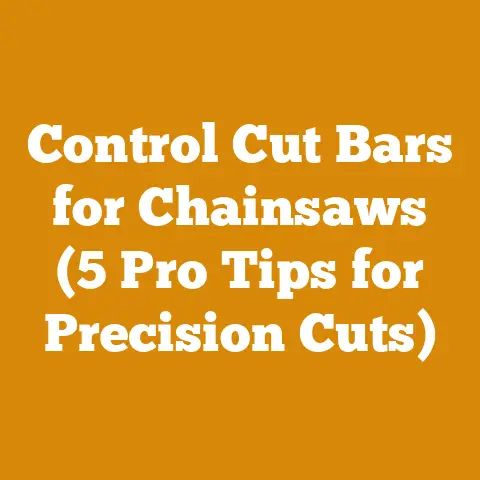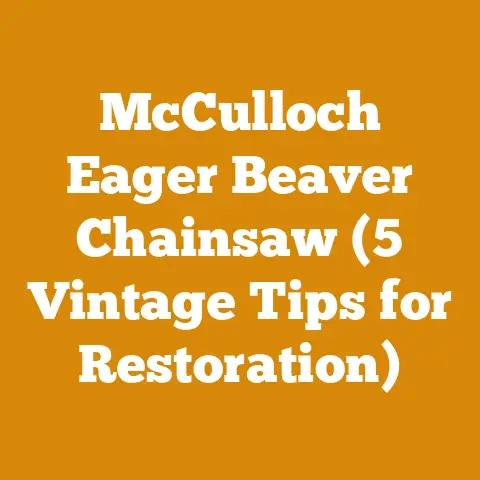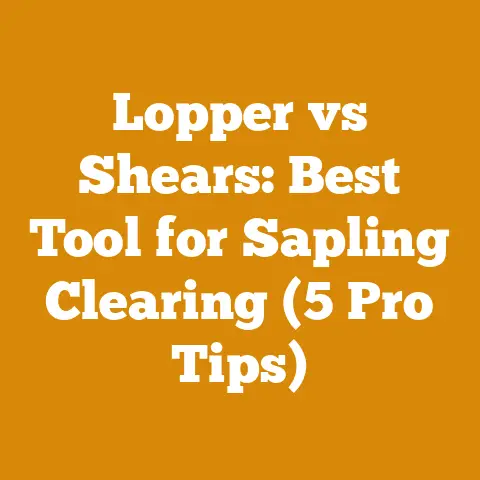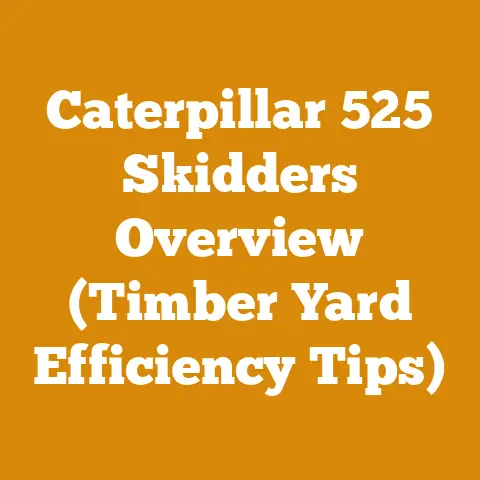Pine Blight Treatment: Effective Sprays for Wood Health (5 Proven Tips)
Understanding Pine Blight and Its Impact
Before diving into treatment, let’s understand what we’re up against. Pine blight, often caused by fungal pathogens like Diplodia pinea or Sphaeropsis sapinea, affects various pine species, leading to needle browning, stunted growth, and, in severe cases, tree death. The disease thrives in stressed trees, making proper care and prevention just as important as direct treatment.
Identifying Pine Blight
- Needle Browning: Look for browning, particularly on the lower branches and new growth.
- Stunted Growth: Reduced needle length and overall growth.
- Cankers: Sunken or swollen areas on branches.
- Resin Exudation: Excessive resin flow from infected areas.
- Dead Twigs: Dieback of twigs and small branches.
Economic Impact
Pine blight can have a significant economic impact, especially for timber growers and homeowners with valuable ornamental pines. The disease can reduce timber yields, increase management costs, and diminish property values. A study by the USDA Forest Service estimates that pine diseases, including blight, cost the timber industry millions of dollars annually in lost productivity and treatment expenses.
Choosing the Right Spray Treatment: A Cost-Effective Approach
Selecting the appropriate fungicide is crucial for effective treatment. However, the cost of fungicides can vary significantly depending on the active ingredient, concentration, and application method. Let’s explore some proven options and their associated costs.
1. Copper-Based Fungicides: The Budget-Friendly Option
Copper-based fungicides, like copper sulfate or copper ammonium complex, are often the most affordable option. They work by disrupting fungal enzyme activity, preventing spore germination and disease spread.
- Cost: Typically, copper-based fungicides range from \$15 to \$30 per gallon of concentrate. A single application may require 1-2 gallons of concentrate per acre, depending on tree size and density.
- Application: Apply in early spring before new growth emerges and repeat every 2-3 weeks during periods of high humidity or rainfall.
- Pros: Relatively inexpensive, readily available, and effective against a broad range of fungal diseases.
- Cons: Can be phytotoxic (harmful) to some plants if applied at high concentrations or during hot weather. May require multiple applications for effective control.
My Experience: I’ve used copper-based fungicides on my own property for years with good results. One year, I had a particularly bad outbreak of Diplodia tip blight. I mixed a copper sulfate solution according to the manufacturer’s instructions and sprayed the affected trees. Within a few weeks, I noticed the browning had stopped spreading, and new growth was emerging. The total cost for the fungicide was around \$50, which was significantly less than other options I considered.
2. Propiconazole: The Systemic Solution
Propiconazole is a systemic fungicide, meaning it’s absorbed by the plant and translocated throughout the tissues. This makes it effective against fungal infections that have already penetrated the tree.
- Cost: Propiconazole is generally more expensive than copper-based fungicides, ranging from \$40 to \$80 per gallon of concentrate. Application rates vary depending on the product and tree size, but typically require 1-2 pints of concentrate per acre.
- Application: Apply in early spring or fall, when the tree is actively growing. Systemic fungicides are often more effective when applied preventatively, before symptoms appear.
- Pros: Systemic action provides longer-lasting protection and can control existing infections.
- Cons: More expensive than contact fungicides. May require specialized equipment for application.
Cost Breakdown Example: Let’s say you have one acre of pine trees affected by blight. You choose to use a propiconazole-based fungicide that costs \$60 per gallon. The application rate is 1 pint per acre.
- Fungicide Cost: 1 pint = 0.125 gallons. Cost per acre = 0.125 gallons * \$60/gallon = \$7.50
- Labor Cost: Assuming you hire a professional applicator at \$50/hour and it takes 1 hour to spray the acre, the labor cost is \$50.
- Equipment Cost: Renting a sprayer costs \$30 per day.
Total Cost: \$7.50 (fungicide) + \$50 (labor) + \$30 (equipment) = \$87.50 per acre.
3. Chlorothalonil: The Broad-Spectrum Protector
Chlorothalonil is a broad-spectrum fungicide effective against a wide range of fungal diseases, including pine blight. It works by inhibiting fungal respiration, preventing spore germination and growth.
- Cost: Chlorothalonil falls in the mid-range, costing between \$30 and \$50 per gallon of concentrate. Application rates vary depending on the product and disease severity, but typically require 1-2 quarts of concentrate per acre.
- Application: Apply in early spring before new growth emerges and repeat every 7-14 days during periods of high disease pressure.
- Pros: Broad-spectrum activity, relatively long-lasting protection.
- Cons: Can be phytotoxic to some plants. May require multiple applications for effective control.
4. Mancozeb: The Protectant Powerhouse
Mancozeb is a protectant fungicide that forms a barrier on the plant surface, preventing fungal spores from penetrating the tissue. It’s particularly effective against diseases like needle cast and rust, which often accompany pine blight.
- Cost: Mancozeb is another budget-friendly option, costing between \$20 and \$40 per gallon of concentrate. Application rates typically require 2-4 pounds of product per acre.
- Application: Apply in early spring before new growth emerges and repeat every 7-10 days during periods of high disease pressure.
- Pros: Relatively inexpensive, broad-spectrum activity, and effective protectant.
- Cons: Requires frequent applications, can leave a visible residue on foliage.
5. Azoxystrobin: The Modern Marvel
Azoxystrobin is a strobilurin fungicide that inhibits fungal respiration, preventing spore germination and growth. It’s highly effective against a wide range of fungal diseases and has both protectant and curative properties.
- Cost: Azoxystrobin is one of the more expensive options, costing between \$80 and \$120 per gallon of concentrate. Application rates typically require 4-8 fluid ounces of product per acre.
- Application: Apply in early spring or fall, when the tree is actively growing. Azoxystrobin has systemic properties, providing longer-lasting protection.
- Pros: Highly effective, broad-spectrum activity, systemic properties.
- Cons: Most expensive option.
Cost Comparison Table:
| Fungicide | Cost per Gallon (Concentrate) | Application Rate (per Acre) | Pros | Cons |
|---|---|---|---|---|
| Copper-Based | \$15 – \$30 | 1-2 Gallons | Inexpensive, readily available, broad-spectrum | Phytotoxic, multiple applications needed |
| Propiconazole | \$40 – \$80 | 1-2 Pints | Systemic, longer-lasting protection | More expensive, specialized equipment may be needed |
| Chlorothalonil | \$30 – \$50 | 1-2 Quarts | Broad-spectrum, relatively long-lasting | Phytotoxic, multiple applications needed |
| Mancozeb | \$20 – \$40 | 2-4 Pounds | Inexpensive, broad-spectrum, effective protectant | Frequent applications, visible residue |
| Azoxystrobin | \$80 – \$120 | 4-8 Fluid Ounces | Highly effective, broad-spectrum, systemic | Most expensive |
5 Proven Tips for Effective Pine Blight Treatment
Beyond choosing the right fungicide, these five tips can significantly improve your treatment success and save you money in the long run.
1. Proper Timing is Everything
Timing is crucial for effective pine blight treatment. The best time to apply fungicides is in early spring, just before new growth emerges. This helps protect the new needles from infection. Repeat applications may be necessary during periods of high humidity or rainfall, as these conditions favor fungal growth.
Data Point: Studies have shown that preventative fungicide applications in early spring can reduce pine blight incidence by up to 80%.
2. Prune Infected Branches
Pruning infected branches is an essential step in controlling pine blight. Remove any branches showing signs of disease, such as browning needles or cankers. This helps to reduce the fungal inoculum and prevent the disease from spreading to healthy parts of the tree.
My Experience: I once had a large pine tree that was heavily infected with pine blight. I spent an entire weekend pruning the affected branches, carefully cutting them back to healthy wood. It was a lot of work, but it made a huge difference. The tree recovered beautifully, and I haven’t had any problems with blight since.
Cost Considerations for Pruning:
- DIY Pruning: If you’re comfortable pruning yourself, the cost is minimal. You’ll need pruning shears, a saw, and potentially a ladder. The cost of these tools can range from \$50 to \$200, depending on the quality.
- Professional Pruning: Hiring a professional arborist to prune your trees can be more expensive, but it ensures the job is done correctly and safely. Arborist fees typically range from \$50 to \$150 per hour.
3. Improve Air Circulation
Pine blight thrives in humid conditions with poor air circulation. Improving air circulation around your trees can help to reduce disease pressure. This can be achieved by pruning surrounding vegetation, thinning out dense branches, and ensuring adequate spacing between trees.
Actionable Tip: Consider removing any shrubs or trees that are crowding your pines and blocking airflow.
4. Fertilize and Water Properly
Stressed trees are more susceptible to pine blight. Proper fertilization and watering can help to keep your trees healthy and resilient. Fertilize your pines in early spring with a balanced fertilizer, following the manufacturer’s instructions. Water deeply during periods of drought, especially during the first few years after planting.
Data Point: A study by the University of Minnesota found that properly fertilized pine trees were significantly less susceptible to pine blight than unfertilized trees.
Cost Considerations for Fertilization:
- Fertilizer Cost: A bag of balanced fertilizer typically costs between \$20 and \$40, depending on the size and formulation.
- Application Cost: You can apply fertilizer yourself using a spreader or by hand. If you hire a professional, the cost will depend on the size of your property and the application rate.
5. Monitor Regularly
Regular monitoring is essential for early detection and treatment of pine blight. Inspect your trees regularly for signs of disease, such as browning needles or cankers. The earlier you detect the problem, the easier and less expensive it will be to treat.
Actionable Tip: Make it a habit to walk around your property every few weeks and inspect your pine trees for any signs of disease.
Cost-Saving Strategies: Maximizing Your Budget
Combating pine blight can be costly, but there are several ways to minimize expenses without compromising treatment effectiveness.
1. Bulk Purchasing
Buying fungicides in bulk can significantly reduce your costs. Many suppliers offer discounts for large orders. Consider partnering with neighbors or other landowners to purchase fungicides together.
Example: A 5-gallon container of copper-based fungicide might cost \$100, while a single gallon costs \$30. Buying in bulk saves you \$50.
2. DIY Application
Applying fungicides yourself can save you a significant amount of money on labor costs. However, it’s essential to follow the manufacturer’s instructions carefully and wear appropriate protective gear.
Safety First: Always wear gloves, eye protection, and a respirator when applying fungicides.
3. Renting Equipment
Instead of buying expensive spray equipment, consider renting it. Many equipment rental companies offer sprayers and other tools for a fraction of the cost of purchasing them outright.
Cost Comparison: Renting a sprayer might cost \$30 per day, while buying one could cost \$200 or more.
4. Preventative Measures
Prevention is always cheaper than treatment. By implementing preventative measures, such as proper pruning, fertilization, and watering, you can reduce the likelihood of pine blight outbreaks and minimize the need for costly fungicide applications.
Long-Term Savings: Investing in preventative measures can save you thousands of dollars in treatment costs over the long term.
5. Local Resources and Subsidies
Explore local resources and subsidies that may be available to help with pine blight treatment. Many states and counties offer cost-sharing programs or technical assistance for landowners managing forest health issues.
Actionable Tip: Contact your local extension office or forestry agency to learn about available resources and programs.
Case Study: A Firewood Business Battles Pine Blight
Let’s consider a real-world example: a small-scale firewood business operating in the Northeast. This business relies on harvesting pine trees from their own land and from local logging operations. They were hit hard by a severe outbreak of pine blight.
The Challenge: The blight threatened their timber supply, potentially leading to significant revenue losses. They needed to implement a cost-effective treatment plan to protect their trees.
The Solution:
- Assessment: They hired a consulting arborist to assess the extent of the blight and recommend a treatment plan. The arborist’s fee was \$500.
- Pruning: They invested in pruning equipment (shears, saw) for \$150 and spent two weeks pruning infected branches. The labor cost was estimated at \$1,000 (based on their hourly wage).
- Fungicide Application: They chose a copper-based fungicide (\$25 per gallon) and applied it themselves using a rented sprayer (\$30 per day). They needed two applications, costing \$100 for the fungicide and \$60 for the sprayer rental.
- Preventative Measures: They implemented a fertilization program (\$500 for fertilizer) and improved drainage in the affected areas (\$200 for drainage materials).
The Results: The treatment plan was successful in controlling the blight and protecting their timber supply. The total cost was \$2,540, but they avoided potentially much larger losses in revenue.
Lessons Learned:
- Early detection and prompt action are crucial.
- A combination of pruning, fungicide application, and preventative measures is most effective.
- DIY application and bulk purchasing can significantly reduce costs.
Calculating Wood Volume and Firewood Value: A Crucial Step in Budgeting
Understanding how to calculate wood volume and firewood value is essential for any wood processing or firewood preparation project. It allows you to accurately estimate the amount of wood you have and its potential worth.
Measuring Logs
- Board Feet: This is a common unit of measurement for lumber. One board foot is equal to 144 cubic inches (e.g., 12 inches long, 12 inches wide, and 1 inch thick).
- Formula: Board Feet = (Length in Feet x Width in Inches x Thickness in Inches) / 12
- Cubic Feet: This is a measure of volume.
- Formula: Cubic Feet = Length in Feet x Width in Feet x Height in Feet
- Doyle Log Rule: A common method for estimating board feet in a log.
- Formula: Board Feet = (Small End Diameter in Inches – 4)^2 x (Length in Feet / 16)
Example: A log is 16 feet long and has a small end diameter of 12 inches. Using the Doyle Log Rule:
- Board Feet = (12 – 4)^2 x (16 / 16)
- Board Feet = 64 x 1
- Board Feet = 64
Measuring Firewood
- Cord: A standard unit of measurement for firewood. A cord is a stacked pile of wood measuring 4 feet high, 4 feet wide, and 8 feet long, totaling 128 cubic feet.
- Face Cord (or Rick): A stack of firewood 4 feet high and 8 feet long, but the width varies. The price of a face cord is typically proportional to its width.
Estimating Firewood Value:
The price of firewood varies depending on location, wood species, and drying time. According to recent data, the average price per cord of firewood in the United States ranges from \$200 to \$400.
Factors Affecting Firewood Price:
- Wood Species: Hardwoods like oak and maple typically fetch higher prices than softwoods like pine.
- Drying Time: Well-seasoned firewood (dried for at least six months) is more valuable than green wood.
- Location: Prices vary depending on local supply and demand.
- Delivery: Delivery charges can add to the overall cost.
Example: You have a cord of seasoned oak firewood. The average price for oak firewood in your area is \$300 per cord. You can expect to sell your firewood for around \$300.
Chainsaw and Wood Splitter Costs: A Detailed Analysis
Chainsaws and wood splitters are essential tools for wood processing and firewood preparation. Understanding the costs associated with these tools is crucial for effective budgeting.
Chainsaw Costs
- Initial Purchase Price: Chainsaws range in price from \$100 for a basic electric model to \$1,000 or more for a professional-grade gas-powered saw.
- Maintenance Costs: Chainsaws require regular maintenance, including sharpening the chain, replacing air filters, and lubricating the bar. These costs can add up over time.
- Fuel Costs: Gas-powered chainsaws require gasoline and oil. Fuel costs can vary depending on the price of gasoline and the amount of use.
- Repair Costs: Chainsaws can break down, requiring repairs. Repair costs can range from \$50 to \$200 or more, depending on the severity of the problem.
Cost Breakdown Example:
- Chainsaw Purchase: \$300
- Annual Maintenance: \$50
- Annual Fuel Costs: \$100
- Repair Costs (over 5 years): \$200
Total Cost over 5 Years: \$300 + (5 x \$50) + (5 x \$100) + \$200 = \$1,250
Wood Splitter Costs
- Initial Purchase Price: Wood splitters range in price from \$200 for a manual model to \$3,000 or more for a hydraulic splitter.
- Maintenance Costs: Wood splitters require regular maintenance, including changing the hydraulic fluid and lubricating moving parts.
- Fuel Costs: Gas-powered wood splitters require gasoline.
- Repair Costs: Wood splitters can break down, requiring repairs.
Cost Comparison Table:
| Tool | Initial Purchase Price | Maintenance Costs (Annual) | Fuel Costs (Annual) | Repair Costs (over 5 years) |
|---|---|---|---|---|
| Chainsaw | \$300 | \$50 | \$100 | \$200 |
| Wood Splitter | \$1,500 | \$75 | \$150 | \$300 |
Drying Time Estimation: A Key Factor in Firewood Value
Drying firewood properly is essential for maximizing its value. Green wood is difficult to ignite, produces less heat, and creates more smoke. Well-seasoned firewood burns hotter, cleaner, and is easier to light.
Factors Affecting Drying Time
- Wood Species: Hardwoods generally take longer to dry than softwoods.
- Climate: Warm, dry climates promote faster drying.
- Stacking Method: Proper stacking allows for good air circulation, which speeds up drying.
- Log Size: Smaller pieces of wood dry faster than larger logs.
Estimating Drying Time
A general rule of thumb is that firewood should be dried for at least six months before burning. However, the actual drying time can vary depending on the factors mentioned above.
Estimating Formula:
- Drying Time (Months) = (Moisture Content (%) – Target Moisture Content (%) ) / Drying Rate (% per Month)
Example:
- Initial Moisture Content: 50%
- Target Moisture Content: 20%
- Drying Rate: 5% per Month
Drying Time = (50 – 20) / 5 = 6 Months
Conclusion: Taking Action to Protect Your Pines and Your Budget
Pine blight can be a devastating disease, but with the right knowledge and treatment plan, you can protect your valuable trees and your budget. By understanding the disease, choosing the appropriate fungicide, implementing preventative measures, and utilizing cost-saving strategies, you can effectively combat pine blight without breaking the bank.
Actionable Takeaways:
- Assess the Problem: Identify the extent of the pine blight infestation and determine the best course of action.
- Choose the Right Fungicide: Select a fungicide that is effective against pine blight and fits your budget.
- Implement Preventative Measures: Prune infected branches, improve air circulation, and fertilize and water properly.
- Monitor Regularly: Inspect your trees regularly for signs of disease and take prompt action when necessary.
- Explore Cost-Saving Strategies: Consider bulk purchasing, DIY application, and renting equipment.
Remember, protecting your pines is an investment in the future. By taking proactive steps to manage pine blight, you can ensure the health and beauty of your trees for years to come. And with careful budgeting and cost management, you can do it all without breaking the bank. Now, go out there and give those pines the fighting chance they deserve!






